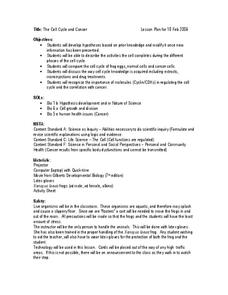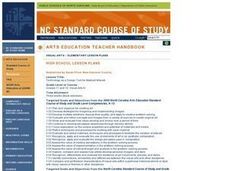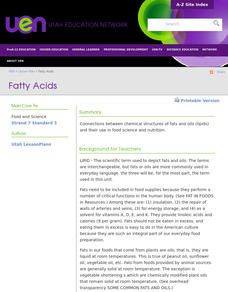Curated OER
The Cell Cycle and Cancer
Students compare and contrast the cell cycle of frog eggs, normal cells, and cancer cells. They watch a video about early development of the frog embryo, generate a hypothesis in small groups, and listen to a teacher-led lecture. ...
Curated OER
DNA Extraction Lab
Students extract DNA and test for its presence from unroasted (raw) wheat germ using a prescribed procedure. They modify the procedure to provide a less expensive, easier method. They also extract DNA from different available plant,...
Curated OER
Electrifying Franklin
Fourth graders research and present information about Benjamin Franklin's life and accomplishments. In this lesson on Benjamin Franklin, 4th graders review idioms and sayings written by Franklin then compare and contrast his various...
Curated OER
Adjective Lessons
Learning about comparative, superlative, and proper adjectives can involve hands-on activties.
Curated OER
Expressive Hands with Stippling Value Shading
Students create a larger than life modified contour drawing of hands in an expressive situation. Hands have linear value, contain a object, and have a patterned background.
Curated OER
Can Acid and Bases Remedy the Body?
Students experiment with acids and bases using technology-based "probe-ware", computers, and household products in this exciting biology/chemistry lesson. The lesson was written for an advanced 6th grade class.
Curated OER
Food Chains and Food Webs
Fourth graders investigate food chains. In this living environment lesson, 4th graders begin to understand the interdependence of organisms. Students describe the connections organisms have to the ecosystem. Students research online,...
Curated OER
Cell Discoveries
Students observe, compare and describe cell organelles in terms of their function, structure and operation. They enter and edit information in a database, build and sort a student-designed database and find records in a database.
Curated OER
Alaska
Fourth graders explore how humans adapt to variations in physical environment, compare how people in different communities adapt to or modify the physical environment and identify and compare the human characteristics of selected regions.
Curated OER
Comparison of hometown life with that of life in a Canadian city
Students research cultural characteristics of a Canadian city with that of their home town. They complete a map handout, providing the relative location on a large map and the absolute location on a provincial map. Students work together...
Curated OER
How Much Water?
Young scholars investigate amount of water available in different countries around the world, compare it to their daily water use, and explore how unequal distribution of water can cause challenges to survival. Students then discuss...
Curated OER
Nutrition Track
Learners examine the importance of a healthy diet based on the USDA food pyramid. They log their daily food intake in a journal. They create charts to analyze and compare their diets to the USDA recommended allowances.
Curated OER
Guantanamera: A Poem and a Song
Students compare revolutionary actions of Jose Marti and Pete Seeger. In this Cuban folk song activity, students listen to the song "Guantanamera" and discuss the content. Students read articles on the poet and the songwriter and create...
Curated OER
Map Your State: Regions of Arizona
Fourth graders define vocabulary and locate physical features on maps. In this mapping lesson, 4th graders explore regions of Arizona through landforms found on topographic maps. Students research the history and culture of...
Curated OER
Technology as a Design Tool for Abstract Artwork
Learners manipulate pictures using Adobe Photoshop and digital cameras to produce unique abstract works. This lesson can be modified to include a painting/mixed media element. State standards are addressed in this lesson.
Curated OER
2.0 "Water Is Life" Global Water Awareness Mini-Unit (Grades3-5)
Students study the amount of potable water on the Earth. In this water instructional activity, students examine the amount of potable water as compared to all the water on the Earth. They discuss why many parts of the world do not have...
Curated OER
Graphing Toad/ Frog Respiration
Learners measure respiratory rates on live toads, and the effect water temperature has on their findings. In this scientific method lesson plan, students record their findings and present them in a graph, comparing the results.
Curated OER
Stewardship of Yosemite National Park
Students devise a plan that would be true to John Muir's spirit of stewardship toward Yosemite. They analyze a core map to determine the original plan and usage of the park and compare the original plan to a current park map.
Curated OER
What Is It?
Play the game of Tag and differentiate between plants and animals. Explore the characteristics of plants. Identify the major parts of plants (e.g., seeds, stem, pistil) and describe their basic functions. Compare the requirements of some...
Curated OER
Fractured Families in American Drama
Students compare and contrast the flawed families in two plays. For this American drama lesson, students read Cat on a Hot Tin Roof and Long Day's Journey into Night. Students research information about the playrights and examine the...
Curated OER
Applied Science - Technology (5A) Lab
Fifth graders explore electromagnetic waves and light. In this light lesson plan, 5th graders draw the parts of a wave of the electromagnetic spectrum. They compare a flashlight to a laser to see how the light looks when shined through...
Curated OER
Road Map Relief - Mixed Media painting
Students use road maps to create non-objective artwork.
Curated OER
Fatty Acids
Identify the properties of fats and lipids. Compare the properties of saturated and unsaturated fatty acids Identify foods containing triglycerides and identify which foods contain saturated and unsaturated fat Discuss the function of...
Curated OER
Making Connections: Exploring Our Brains through the Five Senses
Students record observations and create drawings and models of anatomy using their five senses. They describe the structures of a neuron and analyze each of their functions. They compare and contrast the typical structural features of a...

























